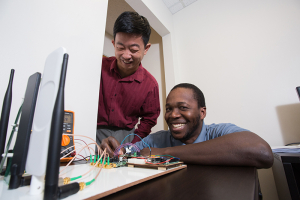It’s hard to imagine a world where you don’t have to worry about charging your cell phone or changing the batteries in your smoke detector. According to electrical and computer engineering doctoral student, Fahira Sangare, that world may be closer than we think.
In a recent presentation to NASA, Sangare discussed his research in energy transfer and harvesting techniques that can be used to power the next-generation of wireless networks.
“What we are trying to do is harvest signals from the air,” said Sangare. “Instead of using a power source through a plug or battery, we are trying to get energy from radio signals that we can harvest and convert into a DC voltage used to power the device.”
This emerging technology involves state-of-the-art circuitry that allows the device to search proactively for the strongest radio signals and a super-capacitor that stores the energy within the device.
“When we find the energy, there are two ways for us to store it. We either use the energy directly to operate or we get the energy and store it in the device,” said Sangare. “The advantage of using a super-capacitor is that it can be charged very fast and it has more recharge cycles. It also lasts longer, making it more environmentally friendly.”
The device must also be multichannel, so if a Wi-Fi signal becomes weaker overtime the device is able to search to find another frequency that it can channel and harvest.
“Currently we are looking at low power devices. For example, a carbon monoxide sensor that is embedded in your house,” said Sangare. “This sensor could have a tag that harvests the energy needed to operate and communicate with your cell phone to alert you if something is wrong.”
When asked about the future, Sangare said he hopes to continue this research and expand its applications.
“I just want to do something that makes an impact on the world. My dream is to find a way get low amounts of energy in the air to power bigger devices like cell phones.”
